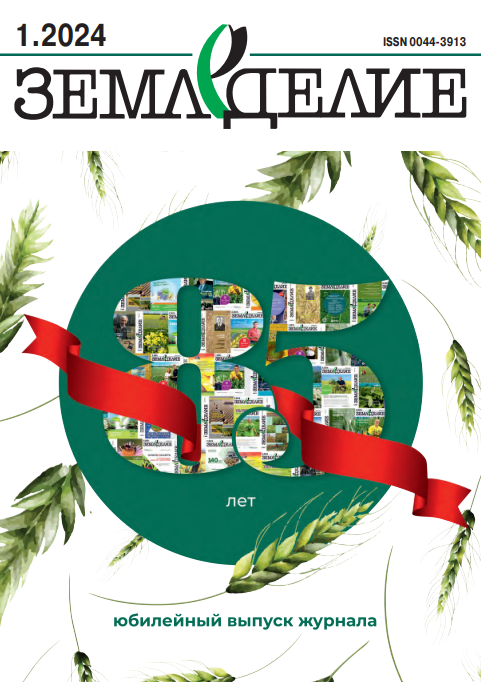Влияние севооборота на эффективность использования пашни при возделывании полевых культур без обработки почвы
DOI: 10.24411/0044-3913-2019-10607
УДК 631.582: 633: 631.153.7
В. К. Дридигер1, доктор сельскохозяйственных наук, руководитель научного направления (e-mail: Адрес электронной почты защищен от спам-ботов. Для просмотра адреса в вашем браузере должен быть включен Javascript.)
Р. С. Стукалов1, кандидат сельскохозяйственных наук, старший научный сотрудник
Р. Г. Гаджиумаров1, научный сотрудник
С. С. Вайцеховская2, кандидат экономических наук, доцент
1Северо-Кавказский федеральный научный аграрный центр, ул. Никонова, 49, Михайловск, Шпаковский р-н, Ставропольский край, 356241, Российская Федерация
2Ставропольский государственный аграрный университет, пер. Зоотехнический, 12, Ставрополь, 355017, Российская Федерация
Цель работы – определение влияния севооборотов на эффективность использования пашни при возделывании полевых культур без обработки почвы на черноземе обыкновенном в зоне неустойчивого увлажнения Ставропольского края. Исследования проводили в 2015–2017 гг. в многолетнем стационарном полевом опыте по изучению 9-и полевых плодосменных севооборотов, схемы которых различались между собой количеством полей (от 4-х до 6-и), набором культур и их чередованием. В структуре севооборотов бобовые культуры занимали от 17 до 33 %, масличные – 17…40 %, зерновые – 50…67 %. При возделывании полевых культур без обработки почвы наиболее эффективно пашня используется в шестипольном севообороте с двумя полями бобовых культур: соя – озимая пшеница – горох – озимая пшеница – подсолнечник – кукуруза, в котором с 1 га севооборотной площади было собрано 3,85 тыс. зерн. ед. себестоимостью 5,46 руб./зерн. ед., прибыль и рентабельность производства продукции растениеводства составили 20888 руб./га и 113,0 %. Высокую рентабельность производства (108,7 и 106,2 %) обеспечивают четырёхпольный (соя – озимая пшеница – подсолнечник – кукуруза) и пятипольный (соя – озимая пшеница – подсолнечник – кукуруза – озимая пшеница) севообороты. Размещение в севообороте озимой пшеницы два года подряд приводит к уменьшению зерновой продуктивности повторных посевов культуры в 1,8…2,0 раза, до 3,48…3,57 тыс. зерн. ед./га и рентабельности производства до 84,4…92,3 %.
Ключевые слова: севооборот, пашня, без обработки почвы, урожайность, прибыль, рентабельность.
Для цитирования: Влияние севооборота на эффективность использования пашни при возделывании полевых культур без обработки почвы / В. К. Дридигер, Р. С. Стукалов, Р. Г. Гаджиумаров и др. // Земледелие. 2019. № 6. С. 28–32. DOI: 10.24411/0044-3913-2019-10607.
Influence of Crop Rotation on the Efficiency of Arable Land Use at the Cultivation of Field Crops without Soil Tillage
V. K. Dridiger1, R. S. Stukalov1, R. G. Gadzhiumarov1, S. S. Vаytsekhovskaya2
1North-Caucasus Federal Scientific Agrarian Center, ul. Nikonova, 49, Mikhailovsk, Shpakovskii r-n, Stavropol’skii krai, 356241, Russian Federation
2Stavropol State Agrarian University, per. Zootekhnicheskii, 12, Stavropol’, 355017, Russian Federation
Abstract. This work aims to study the effect of crop rotations on the efficiency of the arable land use at the cultivation of field crops without tillage in ordinary chernozem in the zone of unstable moistening of the Stavropol Krai. The investigation was carried out in 2015–2017 in the long-term stationary field experiment on the study of nine field crop rotations, which differed by the number of fields (from 4 to 6), a set of cultures and their alternation. In the structure of the crop rotations, the fraction of legumes ranged from 17% to 33%, of oil crops – from 17% to 40%, of cereals – from 50% to 67%. In the cultivation of field crops without tillage, the efficiency of the arable land use depended on the set of crops and their alternation in the crop rotation. The most effective use of arable land was registered in a six-field crop rotation with two fields of legumes: soybean, winter wheat, pea, winter wheat, sunflower, corn, in which 3,850 cereal units (CU) with the cost of 5,46 RUB/CU were obtained per hectare; profit and profitability of crop production amounted to 20,888 RUB/ha and 113.0%. High production profitability (108.7% and 106.2%) was provided by four-field (soybean, winter wheat, sunflower, corn) and five-field (soybean, winter wheat, sunflower, corn, winter wheat) crop rotations. Growing winter wheat for two years running led to a decrease in the yield of the second winter wheat 1.8–2.0 times, which caused a significant reduction in the harvest of grain units to 3,480–3,570 CU/ha of crop rotation area and a decrease in production profitability to 84.4–92.3%.
Keywords: crop rotation; arable land; without tillage; yield; profit; profitability.
Author Details: V. K. Dridiger, D. Sc. (Agr.), head of research group (e-mail: Адрес электронной почты защищен от спам-ботов. Для просмотра адреса в вашем браузере должен быть включен Javascript.); R. S. Stukalov, Cand. Sc. (Agr.), senior research fellow; R. G. Gadzhiumarov, research fellow; S. S. Vаytsekhovskaya, Cand. Sc. (Econ.), assoc. prof.
For citation: Dridiger V. K., Stukalov R. S., Gadzhiumarov R. G., Vаytsekhovskaya S. S. Influence of Crop Rotation on the Efficiency of Arable Land Use at the Cultivation of Field Crops without Soil Tillage. Zemledelie. 2019. No. 6. Pp. 28–32 (in Russ.). DOI: 10.24411/0044-3913-2019-10607.










